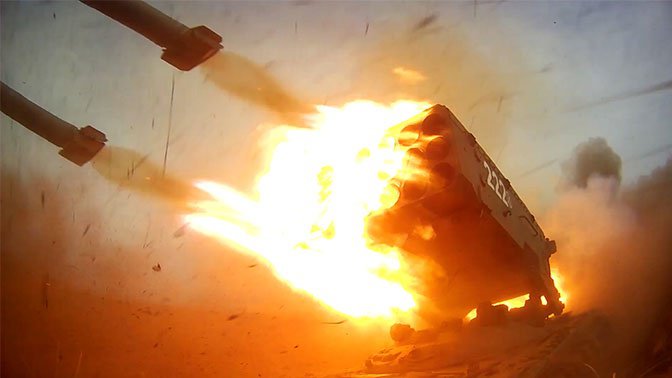Russia's New Heavy Flamethrower Battalion May Violate International Law
Calling these weapons “flamethrowers” seems a bit of a misnomer.
Here's What You Need to Remember: One complication with using thermobaric weapons is international law. While these weapons are not expressly prohibited, Human Rights Watch argues that they are so indiscriminate that they would kill not just soldiers, but any civilians in the target zone.
Heavy flamethrower battalions are coming to the Russian army.
The goal is to use incendiary weapons – devastating physically and psychologically – to clear enemy troops from cities, bunkers and tunnels.
Calling these weapons “flamethrowers” seems a bit of a misnomer. Rather than the backpack-and-nozzle units carried by foot soldiers in World War II, Russia will be using the new TOS-1A Solntsepek (“burning sun”) a multiple rocket launcher – mounted on a T-72 tank chassis – that fires thermobaric rockets. These weapons mix mix fuel and air in a cloud that, when detonated, creates massive heat and pressure effects. Russia has reportedly used the older TOS-1 Buratino in Syria.
“Solntsepek heavy flamethrowers will clear the road for Armata tanks and motorized riflemen,” according to Russian newspaper Izvestia. “They will form battalions, which are armed with those powerful systems, in each military district, Their primary mission is to dislodge the enemy from fortifications.”
Viktor Murakhovsky, a Russian defense expert, boasted to Izvestia that the new thermobaric weapons will so devastate the enemy that the infantry will have a cakewalk occupying the terrain. “‘Solntsepek’ systems provide complete destruction on a large area,” he said. “They are good during the breach of heavily defended fortified areas. Ordinary tube or rocket-propelled artillery will require much more time and ammunition to accomplish a similar mission. Moreover, the result will not be ensured in the end. But the heavy flamethrowers using fuel-air explosive munitions will destroy that defense with one salvo. Later, tanks and motorized riflemen should enter the engagement and, essentially, there will already be no one to offer resistance to them.”
The U.S. military has moved away from the flamethrowers and napalm bombs used during World War, Korea and Vietnam, though there are reports that the M202A1 FLASH – a handheld bazooka-like incendiary rocket launcher – has been used in Afghanistan. However, flame weapons are an integral part of the Russian arsenal.
“In the current structure of the Russian Ground Forces, shoulder-fired flamethrower squads and platoons may be found in the NBC Defense companies of Russian maneuver brigades. Company-sized flamethrower units can only be found in the flamethrower battalions in the NBC Defense regiments of the Combined Arms Armies, Tank Army, and Army Corps,” according to the U.S. Army’s Foreign Military Studies Office. “The typical Russian flamethrower battalion consists of two companies of shoulder-launched flamethrowers, and one company of vehicle-launched ‘heavy’ flamethrowers. The typical shoulder-fired flamethrower company has 71 personnel and nine BMO-T ‘Terminators’ (the BMO-T is a modified T-72 chassis for the transportation of 20-30 of the highly volatile shoulder-fired disposable RPO-A Shmel series flamethrowers). The typical vehicle-launched ‘heavy’ flamethrower company has 35 personnel, three TOS-1A ‘Solntsepek’ heavy flamethrowers, each with 24 220-mm thermobaric rockets mounted on a T-72 chassis, and six TZM-T transporter/loader vehicles that are also mounted on a T-72 chassis.”
One complication with using thermobaric weapons is international law. While these weapons are not expressly prohibited, Human Rights Watch argues that they are so indiscriminate that they would kill not just soldiers, but any civilians in the target zone. Fuel-air explosive also inflict horrific injuries, crushing their victims or crushing their internal organs.
Interestingly, Izvestia noted that “for a long time, the Russian military could not decide on a concept of using these systems, although they have been exported for several years.” Also interesting is that the incendiary and flamethrower weapons are operated by the Russian military’s Nuclear, Biological, and Chemical (NBC) units, which also is responsible for protecting troops from weapons of mass destruction.

Russian military newspaper Red Star asserts that thermobaric weapons reflect Russia’s willingness to conduct assault operations such as storming fortified towns, in contrast to the Western approach of using precision weapons for mobile battles. “The Americans assumed that wars will become contactless - light mobile infantry will conduct in-depth raids under the cover of aircraft,” Red Star said. “They considered assault operations to have receded into the past. As a result, in Viktor Murakhovsky’s words, they spent a year for the seizure of Iraq’s Mosul and the storming of Syria’s Raqqa was dragged out for four months. In the process, the cities were completely destroyed by aircraft.”
Whether razing cities – and wiping out their inhabitants -- with fuel-air explosives is any more efficient or humane remains to be seen. “We had to burn the city to save it” seems a dubious assertion at best.
Michael Peck is a contributing writer for the National Interest. He can be found on Twitter, Facebook. or on his Web site.
This first appeared earlier this year and is being republished due to reader interest.
Image: Wikimedia

